Story and photos by Kali Parmley
It was bitter cold. The wind roared around me and spread the cold deep into my bones while wet snow lashed at my cheeks. It didn’t bother me too much; I had expected this for a late November hunt in southern Idaho. My gloves couldn’t protect my shooting hand from this icy chill, and it was stiff as it held my Citori at the ready. Even if my trigger finger were frozen, it would thaw in a split second if the moment came.
A white speck dashed through the sage in front of me. I saw the tip of his tail disappear into the abyss before reappearing a few yards away. He was quick and quartering through the brush as if this were his hundredth day afield—but it wasn’t. The setter pup I was watching was just six months old. Jones was his name, and he was (is) mine.
His demeanor had changed. No longer was this puppy out for a fun walk, running from human to human for attention, or from dog-to-dog begging for one of them to chase him. He had gotten a whiff of California quail from a large covey that had flushed in his face just minutes prior. That flush had flipped a switch.
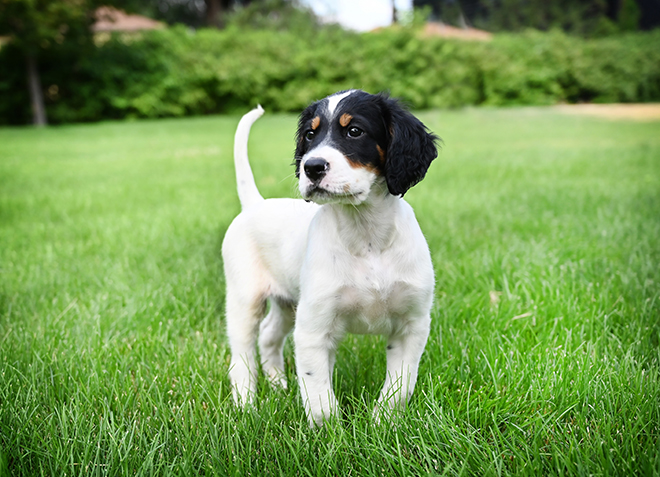
A Love Affair
My grandpa had been a setter man. He spent his retirement transforming his farm that once housed hundreds of Hereford cattle to a setter training sanctuary. I spent a lot of time on that farm. I had my own horse and was an avid rider, so my Grandpa paid me to exercise his trialing horses—it was easy summer money for a high school kid. That’s where my love for setters began.
The smell of cigar smoke, leather, horse sweat, and the sound of barking dogs are all engrained in my memory. I can still hear the buzz of his ATV rumbling across the field and remember the sight of a brace of setters harnessed to the front for exercise. My time on the farm gave me ample opportunity to see his setters work and that’s where my love affair started. The idea of hiking behind my own setter, his tail quivering at high noon, body straight as a board and unwavering, made me want my own classic bird dog.
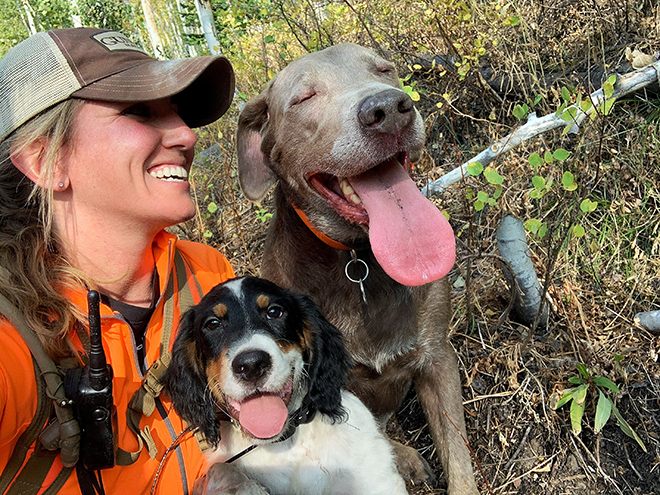
The New Addition
Fast forward 15 years and the idea of Jones was just that: an idea. A possibility that an English setter would be joining my ranks was first fueled by desire when I had placed a deposit on a litter from Jerry Kolter and Betsy Danielson of Northwoods Bird Dogs in the spring of 2019. My Lab was getting up there in age and I needed another bird dog to split the duties with him.
But a year later I was given a sudden opportunity to work remotely and move West—as I had dreamed of for quite some time. I hopped at the chance and moved to Utah where I was now less than an hour from chasing wild birds.
But that threw a wrench in the mix when it came to adding a bird dog to my pack. I was in a new city where my babysitters club was minimal, and I was 24 hours away from friends and family. To be completely honest, however, the real issue wasn’t logistical, but mental: Was I ready for this? I didn’t know if I could handle two dogs
and train a pointing breed.
It had been just me and my beloved Lab, Lincoln, for seven years. He made me a bird hunter. I had minimal dog training experience under my belt when I trained him. Thanks to a very patient dog, we learned together—both training drills and how to be upland hunters. Our bond was iron strong. Did I want another year solo with him before adding a new addition to our home?
However, my biggest panic came from the fear of failure. How do I train a pointing breed?
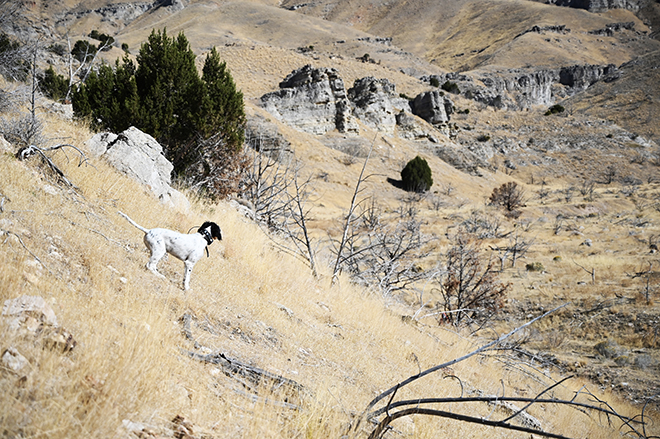
Lingering Doubt
When the call came from Betsy telling me the litter had whelped and one of the males was reserved for me, my excitement was squashed by fear.
Sure, I had read hundreds of articles on training pointing dogs and speak to trainers daily for my job, but that didn’t make me an expert. What if I messed it up? What if my visions of shooting a bird over the staunch point of my setter in some picturesque landscape of the West was replaced by a dog that couldn’t find his food bowl? His success, and failure, rested on me, his handler.
After many calls, texts, and email exchanges to numerous friends, trainers, and Jerry and Betsy, my mind was eased. I could do this.
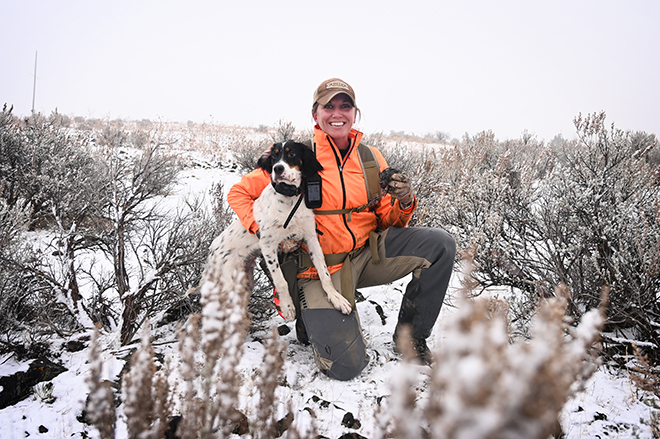
Building a Bird Dog
It’s been tough—I won’t sugarcoat it. Lincoln is seven years old…having to train a puppy after years of having a dog that basically speaks English was rough. But one look at Jones and his big brown eyes and I instantly fall in love with the sweet setter pup over and over again.
Obedience training I had down pat and Jones took to it quickly—his solid breeding showing its true colors right away. Then the lingering anxiety crept in. When do I introduce birds? Gun fire? Do I teach him to sit? Do I start whoa training now? These questions crippled me with fear all over again.
I read my bird dog and did things at his pace when I felt he was ready. At four months I showed him a wing, then progressed to a frozen pigeon. When he pranced around the yard proudly dragging the pigeon, I moved on to a live bird with its wings secured. Jones’ little heart came alive, and he pounced at the pigeon instinctually.
Then I unharnessed one wing and I saw the whites of his big brown eyes as they opened wide in amazement. Two flapping (and clipped) wings later, Jones was chasing that pigeon around my backyard, his prey drive showing itself.
I moved to the field and with ease, that little bird dog found the planted pigeons I had put out. When a buddy blasted a .22 pistol from a hundred yards away, then 50, then 25, Jones gave no mind. The bird was all he wanted.
But he didn’t point the wing or the pigeons he found so easily. Was I doing something wrong? My social media feed was filled with pointing dog puppies doing just that…pointing. Why wasn’t Jones?
Frantic texts to friends for advice eased my fears. He’ll point when he’s tired of the birds flying away, they replied. And they were right. After a frustrating training session where Jones found the pigeons quickly, but still no point, I was exasperated. Just put a wing in his face again, I told myself.
That’s when it happened. After flipping the wing away from his pounce a few times, Jones locked up. Back straight as a board, one paw off the ground, and eyes on the wing—it was as if he were frozen. He had found his point.
A point in the field followed soon afterward. His nose was tracking a couple of planted chukar and I watched hoping for the best. He found the chukar and stopped on a dime in a beautiful tripod point, his tail standing stark straight. His eyes were locked on the birds while my eyes were filling with tears. My little bird dog’s instincts had just come alive.
The Novices
He didn’t seem to mind the cold as much as me on that snowy Idaho hunt—he was focused on one thing: finding the quail.
I had followed him as he peeled away from our friends, his nose to the ground. He was tracking a bird—his body told me. He zagged between the sage, his little frame no longer upright and running. His tail was whirling like a helicopter and he was hunkered low to the ground searching in vain for what he was smelling.
He circled one patch of sage, his nose telling him it was in there—but wild birds don’t play fair. A quail flushed from a bush nearby, and on instinct, I raised my shotgun and the bird fell. Jones ran to retrieve it, running with it in his mouth in excitement. It wasn’t a point, but he had found that bird and I couldn’t have been prouder of him.
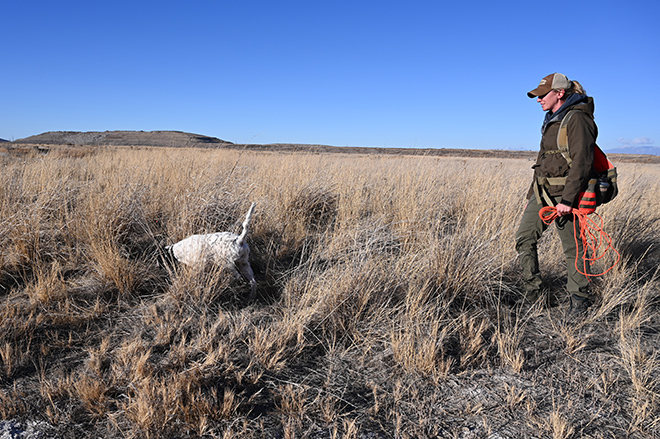.jpg.aspx)
We are both novices in a sense. Jones and I are learning together how to make him the best bird dog he can be, and me a better trainer. My journey has led me to understand this concept: Each bird dog puppy develops at their own time, and in their own way. I can help Jones along, but his natural instincts will trump me any day. Watching him grow, learn, and develop makes me swell with pride and I’m going to sit back, soak up the process, and enjoy the ride.
Kali Parmley is editor-in-chief of Gun Dog Magazine